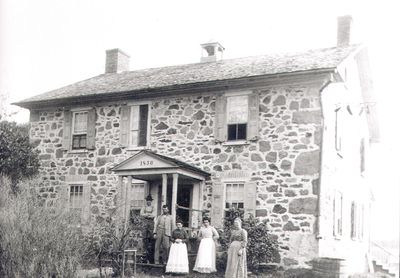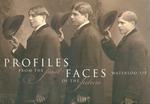Magdalena and John E. Brubacher
Magdalena Brubacher was a Mennonite pioneer who had
fourteen children in a home made from fieldstone, on a
farm in northwest Waterloo. The large home, built in
1850 by her husband John E. Brubacher, still stands,
and has become a museum known as the Brubacher House.
While documents reveal little of the woman who nurtured this historic family, accounts
from her many children give impressions of her daily life: there were mince meat pies
stored in the attic, and spinning wheels that made linen from flax grown on the farm.
Clothing was handmade, and “the weekly washing for a large family was heavy work and
the daily cooking for a family of thirteen children and two adults must have been
accomplished through organization and good management.”
Magdalena Musselman married John E. Brubacher in 1846. Her children’s
birth dates reveal that she gave birth every year or two from the time she was nineteen
until she was 42-years-old. There are no details about the one child who apparently died
in infancy.
There was a creek on the 254-acre property where the boys fished, and an orchard that
was the pride of John Brubacher. The fish were salted and kept in barrels and there were
peacocks and “all kinds of fowl.” There was a fireplace in the kitchen where Brubacher
would have prepared meals, and a bedroom where she and her husband and the “very
small children” slept. There was a dinner bell to alert the men working in the fields.
The land they farmed was part of Lot 25 of the German Company Tract, which was
purchased by German Mennonite families living in Lancaster County, Pennsylvania, in
the early nineteenth century. Brubacher’s father, also named John, bought land in 1842,
and in 1863 John E. Brubacher took over possession of the land from his father.
It is written that “every youngster had their little chores at an early age and were kept in
line by their older sisters. This system really worked and it took a great deal of pressure
from the parents.” In the basement was a utility fireplace where food was prepared in the
hot summer months, and where soap was boiled and lard rendered. It would also have
been the place where water was boiled for laundry done in large wooden tubs.
There is one story often told of a hired man named Adam who had difficulty getting up
for a hard day’s work on the Brubacher farm. One morning John went to his room to
waken him. Adam reportedly replied from the “depths of a feather tick, - I am here, but I
am naked and ashamed.”
In September 1867, John and Magdalena took a three-day train trip from Preston to
Harrisburg, Pennsylvania, leaving the children to manage the farm while the couple
visited their American cousins. “Old friendships were renewed; the hospitality of the
Brubacher and Musselman cousins made the trip most enjoyable and always to be
remembered.”
At some point the health of Magdalena began to fail, and in 1877 it was decided that she
should have an operation. Her kitchen was turned into an operating room and she was
given chloroform to dull the pain and render her unconscious. The large kitchen table
where she had shared meals, prepared food, sewn quilts and overseen homework, became
the operating table for her surgery.
Unfortunately, within two weeks of the operation, Magdalena Brubacher died on July 5,
1877 at the age of forty-nine. It was a great shock to her family, especially the youngest
daughter Harriet who was only seven years old.
It is written that life in the Brubacher home was never the same after Magdalena’s death.
John E. Brubacher was remarried to his late wife’s sister Esther when Harriet was twelve
years old. Harriet Brubacher never married, and after her father died in 1902, she
became an accomplished seamstress and lived at the homes of her brothers and sisters.
Magdalena and John E. Brubacher (Waterloo 150 Profile)
Description
- Creator
- Gallagher, Beth, Author
- Media Type
- Text
- Image
- Description
- To celebrate Waterloo's 150th anniversary, the Waterloo Public Library published a book called "Profiles from the Past, Faces of the Future." This book featured 150 profiles of people who helped make Waterloo what it is today. This is the digitized profile for Magdalena and John E. Brubacher.
- Notes
- Please visit the Waterloo Public Library to enquire about physical copies of "Profiles from the Past, Faces of the Future."
The Waterloo 150 project was funded by a grant from the Waterloo Regional Heritage Foundation. Beth Gallagher wrote the profiles with the assistance of many research volunteers. Information for the profiles was gathered from a variety of sources from the community and the Ellis Little Local History Room. Notable sources include the Ellis Little Papers, newspaper clippings, local magazines and books. - Place of Publication
- Waterloo, Ontario
- Date of Publication
- 2007
- Subject(s)
- Personal Name(s)
- Brubacher, Magdalena ; Brubacher, John ; Brubacher, Harriet ; Brubacher, Esther
- Language of Item
- English
- Geographic Coverage
-
-
Ontario, Canada
Latitude: 43.4668 Longitude: -80.51639
-
- Copyright Statement
- Uses other than research or private study require the permission of the rightsholder(s). Responsibility for obtaining permissions and for any use rests exclusively with the user.
- Contact
- Waterloo Public LibraryEmail:askus@wpl.ca
Website:
Agency street/mail address:35 Albert Street, Waterloo, Ontario, Canada, N2L 5E2
- Full Text




